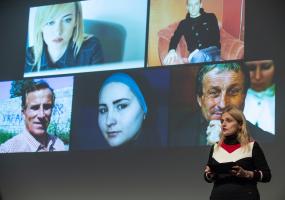‘Let’s call it.... journalism?’
27 Feb 2013
Anuradha Sharma writes:"Let's call him Vasu". In the opening line of his book Let's Call Him Vasu (Penguin, 2012), Shubhranshu Choudhary doesn't seem to waste much thought in assigning a name to his first Maoist contact, whose real name is not revealed. What seems to put him on a sticky wicket, though, is what his initiative to link tribal communities in India should be called. Journalism, citizen journalism, guerrilla journalism, or rather, activism or advocacy. "No, we are not a journalistic organisation in the way we know journalism," he said in response to a question after his presentation on 'How New Technology Can Help to Democratise the Media'. Mainstream journalism, Mr. Choudhary explained, is "aristocratic" in that a handful of people sitting at the top decide what is news. "We need to democratise the communication system," he said. It was with this objective that Mr Choudhary launched CGNet Swara, a voice-based portal, in 2010 in the tribal areas of his home state, Chhattisgarh, in central India. A "voice twitter" for the poor and largely illiterate tribal population, it allows a caller—a voice blogger or citizen journalist—to record a voice message. "We then crosscheck, verify, transcribe and translate to post these messages on our website (cgnetswara.org)," he said. The cellphones also function like a "community radio" in that the villagers can call in and listen to the messages posted on CGNet Swara, he added. Just like other social media platforms, CGNet Swara enables local people, otherwise cut off due to distance, terrain and language, to form a direct link with mainstream media and also the government authorities. "The objective is to give a voice to the voiceless, all those people who are left out in India’s growth story," Mr Choudhury said. The posts on CGNet Swara (Chhattisgarh Net Voice) cover a wide range of issues. Some of the headlines at the moment are 'Adivasis summoned for CM meeting, walk back home in night without food', 'Illiterate widow in MP (Madhya Pradesh) not getting her pension from 8 months, pls help her' and 'In our forest village we have no electricity, no road, no anganwadi, Pls help'. Occasionally, there are also songs and poems, giving creative vent to the people. Is the model effective? Has there been any result? For an answer, Mr. Choudhury replayed the audio clip of Valla Tamireddy of a village in Andhra Pradesh. He reported that the district collector (magistrate) sanctioned a housing project at his village after hearing of the terrible conditions of villagers’ homes via CGNet Swara. The "rocket science" that went behind creating the platform, Mr. Choudhury said, was linking the mobile phone to the computer and the internet. "Simple!" Mr. Choudhury came upon this idea during his interactions with the tribal population while covering the Maoist movement for the BBC, which he quit in 2004. "The prime minister had described it at the biggest internal security threat and those docile tribal boys and girls, who could have been the shy backbencher classmates of mine, were the dreaded terrorists!" According to Mr. Choudhary, the root of the problem lay in the communication divide and the frustration of the tribal citizens at not being heard. The Maoist problem, he maintains, is actually a "communication problem". Nobody is willing to listen to the voices of the tribal people because their news go out only when a handful of "elites decide that there is a story worth telling" and the "interest of this community (the adivasis) is diametrically opposite to that of the bigger community". Then there was one peculiar phenomenon. Basic amenities, such as roads, drinking water, and electricity, are well nigh absent but people own mobile phones. "Just like you go to market to buy provisions, these villagers walk up to the nearest bazaars which have electricity supply just to get their mobile phones charged," Mr. Choudhury said. Mr. Choudhury's experiment was to make use of these mobile phones to get people to speak out and make themselves heard through his "dialogue model of communication". CGNet receives about 300 calls every day. Buoyed by the initial success, he now plans to spread his area of operation to other tribal zones, in the Indian states of Jharkhand, Madhya Pradesh and Andhra Pradesh. "We are looking at various possibilities and trying to innovate our communication model. Let’s see if we can come up something like poor people's Google." But what do you call it, this experiment? Journalism without journalists? This was the question that concerned most of the journalists, academics and experts in the audience. "If you don't want to call it journalism, it’s okay," Mr. Choudhary said at one point. "Is it journalism? I do not know. Do we coin a new word? I do not know..." "What we are trying to do is democratise news, give power in the hands of the people to decide their news," he added later. Moderator John Lloyd summed it up like this: "On a very, very broad definition of journalism, it's journalism. You are not story-tellers as journalists like to think we are. You are story enablers; you are enabling stories to be told." Redefining journalism? Probably.




